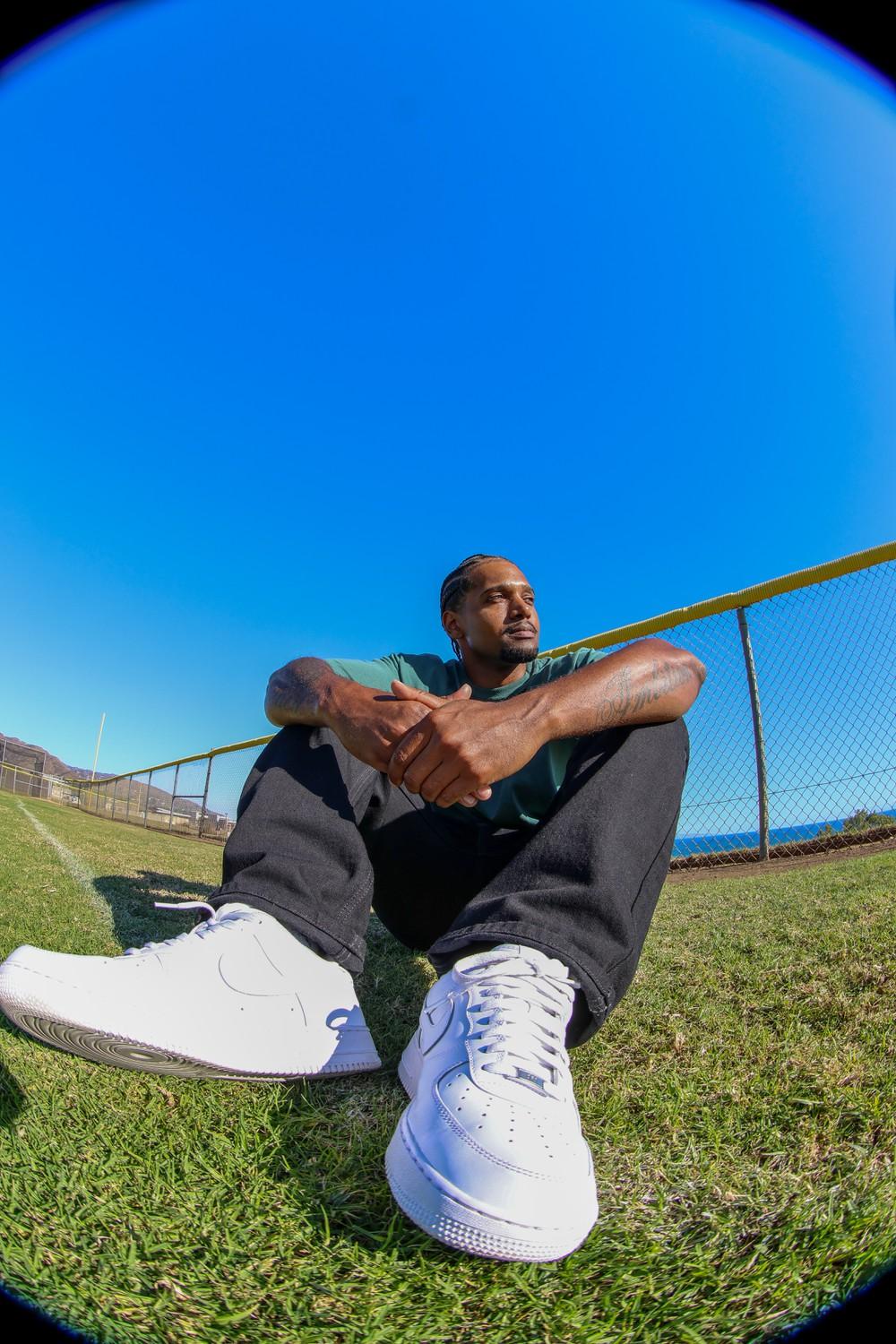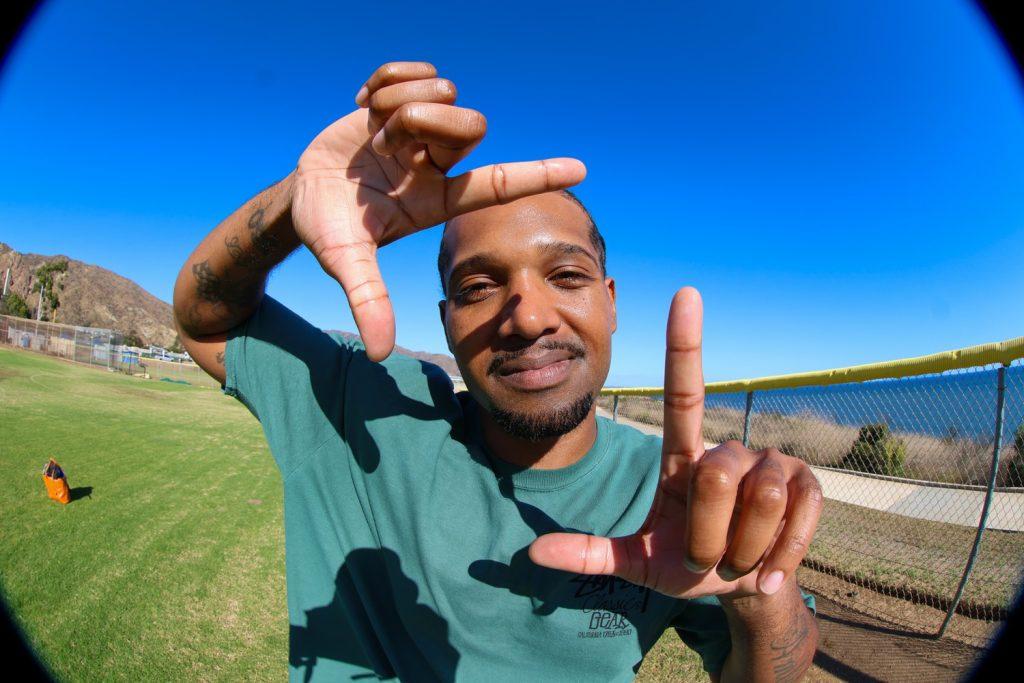Kenard poses with his fingers at Malibu Bluffs Park on Oct. 15. Kenard is from Canton, Ohio, but now lives in the Los Angeles area and is a student at Pepperdine University.
Hip-hop is a middle-aged man. His beard is long, his clothes are new and he’s taken on a different tone than the one he used to be recognized by. His distinctive qualities that people identified him with back in the late 1980s feel like nothing more than a distant memory. He changed.
“I do believe it [hip-hop] isn’t just music, but it’s a culture that involves DJ-ing, break-dancing, graffiti and then rap, as all respectable pillars of the culture,” senior Ephraim Rodriguez said.
Rodriguez grew up in East Los Angeles, listening to hip-hop music on the radio and with his older brother. Along with his exposure to the music, Rodriguez said he believes he was exposed to hip-hop’s culture through different facets of urban life in Los Angeles.
When Rodriguez was in high school in the early 2010s, he said he observed that period as a time when major change came to the genre. Artists who didn’t fit the stereotypical image the genre had come to be known for were changing the culture.
Rodriguez said he observed some artists from that era being responsible for breaking down so many walls that originally held up the template of hip-hop. He recalls people thinking the genre had already died, and expressed the further change as “beating a dead horse.”
Hip-hop has worn very different hats in its 52-year history, and artists, at different points in time, have made their thoughts clear on the change hip-hop was going through.
The artist Common released his version of a love letter to the genre in 1994, titled “I Used To Love H.E.R.,” in which he reflects on the history of hip-hop and how much the genre has changed since he first fell in love with it. He reflected on the genre’s roots and discussed the change the genre had gone through as the West Coast came onto the scene, a huge part of the genre’s change in the mid-90s.
Hip-hop artist Nas, who NPR called “one of the greatest MCs of all time,” released an album called “Hip-Hop Is Dead” 12 years after “I Used to Love H.E.R.” Nas’s title took on a more extreme look compared to Common’s 1994 track.
In 2021, 15 years after the album was released, Nas said the album’s title was directed mainly to New York, the artist’s hometown, on an episode of “The Bridge: 50 Years of Hip Hop,” but it still makes listeners wonder what the hip-hop we have today is.
In his 2018 track “GREY,” artist Saba views all the different phases as part of the evolution of the genre and the expected role from the artists over time. Saba said, “First they wanted it hip-hop, and then they wanted guerilla, and then they wanted drug dealer, and then they wanted a dancer, now they want a drug addict.”
From a non-artist perspective, Rodriguez said hip-hop went through changes after its inception, from the days when it was known for more than just music in New York City to its gangsta rap days.
About a decade later it eventually turned into a sales competition with hipster rap entering the mainstream, and the decade that followed saw the takeover of trap music, which led the genre to where it is today.
 Junior Arin Kenard sits at Malibu Bluffs Park on Oct. 15. Kenard is a hip-hop artist known as Pablo Sanders. Photos by Melissa Houston
Junior Arin Kenard sits at Malibu Bluffs Park on Oct. 15. Kenard is a hip-hop artist known as Pablo Sanders. Photos by Melissa Houston
Junior Arin Kenard, also known by his stage name Pablo Sanders, said he has been a fan of hip-hop for the past three decades, and eventually began making his own hip-hop music. Kenard sees the change of the genre that he’s now a part of, and notices how diverse the sound within the genre has become.
“Times change and the sound changes,” Kenard said. “It’s so many different subgenres within hip-hop, compared to in the past where it’s, just like one or two different versions, where it’s like their own little worlds, that they all have their own audiences for, which is pretty cool.”
Kenard talked about how there’s a variety of subgenres within hip-hop, something that’s evident when looking through all the different artists and albums that represent hip-hop over the past 50 years.
The middle-aged man I described in the beginning didn’t just age and stay steady — he’s already lived a full life, and he’s still changing. If the past has served as a basis for what to expect in the future, you can’t predict the change that’s coming.
New, fun and dynamic styles are constantly changing the sound of hip-hop music, and as a consequence, changing the culture. If anyone were to argue with that, I would encourage them to review the standards of what’s expected from hip-hop and how much they have changed over time.
When backpack rap became a growing subculture within hip-hop, it defied so much of what mainstream hip-hop was about. In the 2010s, it became culturally acceptable for rappers to be emotionally vulnerable on records.
In the past 15 years, the perception of female rappers has taken a different tone.
At the same time, hip-hop music, just like all other kinds of music, is the product of artistic people expressing themselves and their surrounding culture through their talents.
“Hip-hop means to me, self expression,” Kenard said. “Bringing your true self, your true thoughts, to the world to hear and hopefully get something from.”
Hip-hop has changed, and there’s no reason to think that it won’t change again. Is that bad? Kenard said 10 years after he started releasing music, at the age of 35, he’s still changing.
“I think I’m still changing, because if I don’t, then I feel like I’m dying,” Kenard said. “So I just got to keep going and see how far our good can go.”
__________________
Follow the Graphic on X: @PeppGraphic
Email Nick Charkhedian: nareg.charkhedian@pepperdine.edu


